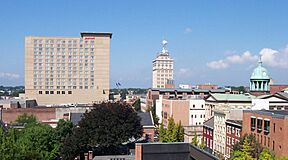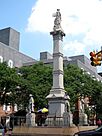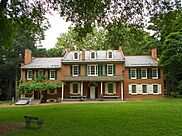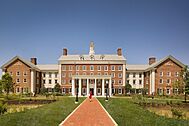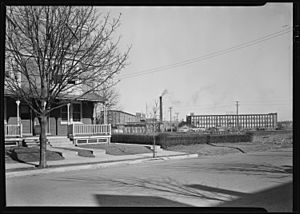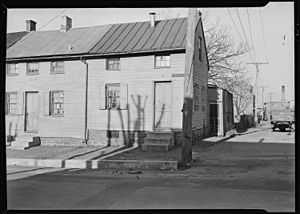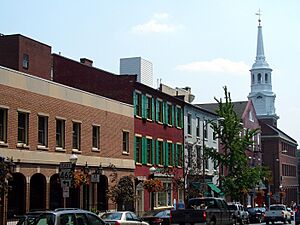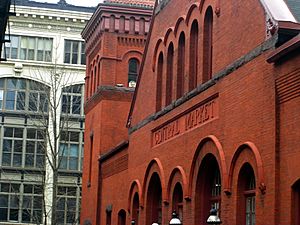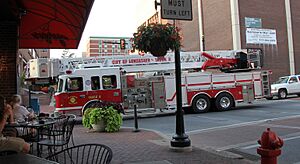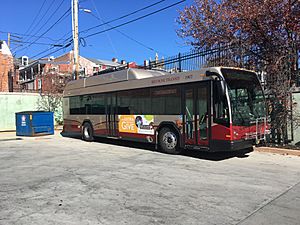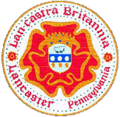Lancaster, Pennsylvania facts for kids
Quick facts for kids
Lancaster, Pennsylvania
|
|||
|---|---|---|---|
|
Lancaster skyline
Franklin & Marshall College
|
|||
|
|||
| Nickname(s):
The Red Rose City
|
|||
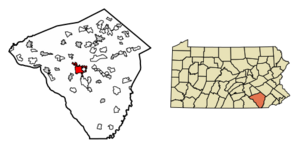
Location of Lancaster in Lancaster County, Pennsylvania.
|
|||
| Country | |||
| State | |||
| County | Lancaster | ||
| Founded | 1729 | ||
| Incorporated (borough) | 1742 | ||
| Incorporated (city) | 1818 | ||
| Founded by | James Hamilton | ||
| Named for | Lancaster, Lancashire, England | ||
| Seat | Lancaster County | ||
| Government | |||
| • Type | Strong mayor − council | ||
| Area | |||
| • City | 7.35 sq mi (19.03 km2) | ||
| • Land | 7.23 sq mi (18.72 km2) | ||
| • Water | 0.12 sq mi (0.31 km2) | ||
| • Metro | 802 sq mi (2,080 km2) | ||
| Elevation | 368 ft (112 m) | ||
| Population
(2020)
|
|||
| • City | 58,039 | ||
| • Rank | 10th in Pennsylvania | ||
| • Density | 8,030.86/sq mi (3,100.60/km2) | ||
| • Urban | 394,531 (US: 107th) | ||
| • Urban density | 2,173.3/sq mi (839.1/km2) | ||
| • Metro | 552,984 (US: 104th) | ||
| Demonym(s) | Lancastrians | ||
| Time zone | UTC−5 (EST) | ||
| • Summer (DST) | UTC−4 (EDT) | ||
| ZIP Codes |
17573, 17601−17608, 17611, 17622, 17699
|
||
| Area codes | 717 and 223 | ||
| FIPS code | 42-41216 | ||
Lancaster is a city in Pennsylvania, USA. It is the main city of Lancaster County. In 2020, about 58,000 people lived here, making it the tenth largest city in Pennsylvania. It's a big city in South Central Pennsylvania, with over 550,000 people living in the wider Lancaster area.
Lancaster was settled in the 1720s. It is one of the oldest cities in the United States that is not on the coast. From 1799 to 1812, it was the capital of Pennsylvania. Today, Lancaster is known for healthcare, tourism, and manufacturing. It is also a key part of Pennsylvania Dutch Country.
Contents
History of Lancaster
Early Days and Founding
The city was first called Hickory Town. It was renamed Lancaster by John Wright after the city of Lancaster in England. The city's symbol, the red rose, comes from the English House of Lancaster.
William Penn included Lancaster in his 1681 Penn's Woods Charter. The city was planned by James Hamilton in 1734. It became a borough in 1742 and a city in 1818.
In 1744, an important treaty was signed in Lancaster. It was between the Haudenosaunee Confederacy and the Provinces of Pennsylvania, Maryland, and Virginia.
Lancaster During the American Revolution
During the American Revolution, Lancaster was the temporary capital of the United States for one day. This happened on September 27, 1777. The Continental Congress moved here after Philadelphia was captured by the British. The government then moved to York, Pennsylvania.
Lancaster in the 1800s
Lancaster was the capital of Pennsylvania from 1799 to 1812. The state capital then moved to Harrisburg. For a long time, from 1800 to 1900, Lancaster was one of the 100 largest cities in the United States.
The first long-distance paved road in the U.S. was the Philadelphia and Lancaster Turnpike. It opened in 1795 and connected Lancaster and Philadelphia. This road was paved with stone and gravel.
Lancaster was home to several important people. James Buchanan, the 15th President of the United States, lived at Wheatland. Thaddeus Stevens, a powerful member of the U.S. House of Representatives, lived here as a lawyer. He was known for wanting to end slavery. The Fulton Opera House is named after Robert Fulton. He was a Lancaster native who invented the first working steamboat.
After the American Revolution, Lancaster became a center for making iron. Two important products for pioneers were made here: the Conestoga wagon and the Pennsylvania long rifle. The Conestoga wagon was named after the Conestoga River.
In 1803, Meriwether Lewis visited Lancaster. He learned how to survey land from Andrew Ellicott. This training helped him lead the Lewis and Clark Expedition.
In 1879, Franklin Winfield Woolworth opened his first successful "five and dime" store in Lancaster. This was the start of the F. W. Woolworth Company.
Recent History (20th and 21st Centuries)
In 2000, Lancaster won the All-America City award. This award recognizes cities for their community efforts.
On October 13, 2011, Lancaster's City Council made September 27 Capital Day. This holiday remembers the day Lancaster was the U.S. capital in 1777.
Lancaster has become known as "America's refugee capital." It welcomes many refugees, about 20 times more per person than other parts of the U.S. Between 2005 and 2019, nearly 5,000 refugees settled in Lancaster. In 2017, Nobel Prize winner Malala Yousafzai visited Lancaster to honor its support for refugees.
Geography and Climate
Location and Neighborhoods
Lancaster is located in the Piedmont region of Pennsylvania. The city covers about 7.35 square miles (19.03 square kilometers). Most of this area is land.
Lancaster has many different neighborhoods, each with its own feel:
- Cabbage Hill/The Hill
- Chestnut Hill
- Downtown/Center City
- Gallery Row/Arts District
- Northwest Corridor
- Penn Square
- Uptown
- West End
- Woodward Hill
- Musser Park
Weather in Lancaster
Lancaster has a climate with warm summers. The hottest temperature ever recorded was 107°F (42°C) in August 1918. The coldest was -16°F (-27°C) in January 1984.
On average, the city gets about 42 inches (107 cm) of rain each year. September is usually the wettest month. Lancaster gets about 203 sunny days a year.
People of Lancaster
| Historical population | |||
|---|---|---|---|
| Census | Pop. | %± | |
| 1790 | 3,762 | — | |
| 1800 | 4,292 | 14.1% | |
| 1810 | 5,405 | 25.9% | |
| 1820 | 6,633 | 22.7% | |
| 1830 | 7,704 | 16.1% | |
| 1840 | 8,417 | 9.3% | |
| 1850 | 12,369 | 47.0% | |
| 1860 | 17,603 | 42.3% | |
| 1870 | 20,233 | 14.9% | |
| 1880 | 25,769 | 27.4% | |
| 1890 | 32,011 | 24.2% | |
| 1900 | 41,459 | 29.5% | |
| 1910 | 47,227 | 13.9% | |
| 1920 | 53,150 | 12.5% | |
| 1930 | 59,949 | 12.8% | |
| 1940 | 61,345 | 2.3% | |
| 1950 | 63,774 | 4.0% | |
| 1960 | 61,055 | −4.3% | |
| 1970 | 57,690 | −5.5% | |
| 1980 | 54,725 | −5.1% | |
| 1990 | 55,551 | 1.5% | |
| 2000 | 56,348 | 1.4% | |
| 2010 | 59,322 | 5.3% | |
| 2020 | 58,039 | −2.2% | |
| 2023 (est.) | 57,153 | −3.7% | |
| Sources: | |||
In 2020, Lancaster had a population of 58,039 people. About 40% of the people were Hispanic/Latino. About 39% were non-Hispanic White, and 12.6% were non-Hispanic Black.
Many people in Lancaster have Puerto Rican heritage. In 2010, about 29% of residents were of Puerto Rican ancestry. Because of this, Lancaster is sometimes called the "Spanish Rose." The city celebrates its Puerto Rican heritage every year with a festival.
The average age in the city is 30 years old. About 27.5% of the population is under 18. Many families live in Lancaster.
Economy and Shopping
Downtown Lancaster
Since 2005, downtown Lancaster has grown. It now has many unique shops, boutiques, restaurants, and art galleries.
Burle Business Park is the city's only commercial and industrial park. It started in 1942 as a U.S. Navy electronics plant.
Shopping Centers
Park City Center is the largest indoor shopping mall in South Central Pennsylvania. It has over 150 stores.
The Lancaster Central Market was built in 1889. It is the oldest farmers' market in the United States that has been open continuously. Many visitors come to buy handmade Amish goods here. The market is a historic place.
Lancaster also has two outlet shopping centers. These are Tanger Outlets and The Shops at Rockvale. They offer many stores and restaurants.
Major Employers
Some of the biggest employers in Lancaster include:
- Lancaster General Hospital
- Giant Food Stores
- County of Lancaster
- Nordstrom, Inc.
- Eurofins Lancaster Laboratories Inc.
- School District of Lancaster
- Dart Container Corporation
Arts and Culture
Historical Landmarks
Lancaster has many important historical places:
- Central Market (1889) – The oldest continuously running farmers' market in the U.S.
- Bethel African Methodist Episcopal Church (1879) – This church helped formerly enslaved people move North. It was also a stop on the Underground Railroad.
- Cork Factory Hotel (1865) – Once a cork factory, now a hotel and apartments.
- Fulton Opera House – The oldest continuously running theater in the U.S. It is a National Historic Landmark.
- Hamilton Watch Complex – Former factory of the Hamilton Watch Company. They made the first battery-powered watch in 1957.
- Historic Rock Ford (1794) – Home of General Edward Hand, who worked with George Washington.
- J. P. McCaskey High School (1938) – Built in the Art Deco style.
- Historic St. Mary's Church (1854) – Has served German-speaking Catholics since 1741.
- Lancaster Arts Hotel (1881) – A former tobacco warehouse, now a hotel with an art gallery.
- Wheatland – The historic home of James Buchanan, the 15th U.S. President.
Art and Museums
Lancaster has a lively art scene. Many art galleries are found on Gallery Row. The city has over 40 galleries and artist studios. On the "First Friday" of each month, galleries stay open late to show new art.
Museums in Lancaster include:
- Demuth Museum – In the former home of painter Charles Demuth.
- Lancaster Museum of Art
- Philips Museum of Art at Franklin & Marshall College.
- Pennsylvania College of Art and Design gallery.
- Hands-on House (Children's Museum of Lancaster) – A fun place for kids to learn.
- North Museum of Nature and Science – For those interested in nature and geology.
- National Watch & Clock Museum – Has the largest collection of clocks and watches in North America.
The Stevens and Smith Historic Site shows the home of U.S. Senator Thaddeus Stevens. It also has a hidden water cistern that was used to hide enslaved people on the Underground Railroad.
The Landis Valley Museum shows the history and culture of the area. It focuses on the German Amish and Mennonite communities.
Music and Entertainment
The Lancaster Symphony Orchestra has been performing since 1947. The Fulton Opera House is one of the oldest working theaters in the United States. The Ware Center also hosts live shows and concerts.
Sports in Lancaster
Professional and College Sports
Lancaster has several sports teams:
- Lancaster Stormers – A professional baseball team. They play at Clipper Magazine Stadium. They have won the Atlantic League Championship three times.
- Pennsylvania Classics – A men's soccer team.
- Lancaster Inferno FC – A women's soccer team.
- Franklin & Marshall College has many sports teams, including the Diplomats football team. They play at Shadek Stadium.
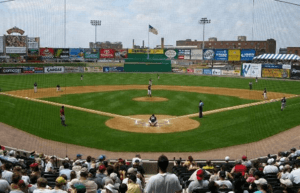
Famous Athletes from Lancaster
Tom Herr, a former Major League Baseball player, is from Lancaster. He played for the St. Louis Cardinals for most of his career. He also managed the Lancaster Stormers in their first season.
Jim Furyk, a professional golfer, is from the Lancaster area. He has won the U.S. Open golf tournament. The Lancaster Country Club hosted the U.S. Women's Open golf tournament in 2015 and 2024.
Other Sports
The Lancaster Bicycle Club holds an annual bike race called the Covered Bridge Metric Century.
USA Field Hockey chose Lancaster County for its national training center for the U.S. women's field hockey team.
Education in Lancaster
Education in Lancaster is provided by public and private schools. The School District of Lancaster runs the city's public schools. It is the second oldest school district in Pennsylvania, started in 1836.
Local high schools include McCaskey and McCaskey East. Lancaster Catholic High School was founded in 1926. Lancaster Country Day School is a large independent school. La Academia Partnership Charter School is the only public charter school in Lancaster County.
The Lancaster area also has several colleges and universities:
- Franklin & Marshall College
- Lancaster General College of Nursing & Health Sciences
- Lancaster Theological Seminary
- Lancaster Bible College
- Pennsylvania College of Art and Design
- Thaddeus Stevens College of Technology
- Millersville University of Pennsylvania
- Harrisburg Area Community College
Media and News
Print Media
- LNP – The main newspaper for the county.
- La Voz Hispana – A Spanish-language newspaper.
- Sunday News – A weekly newspaper.
- Fly Magazine – A guide to downtown Lancaster.
Television
Lancaster is part of the Harrisburg-Lancaster-York TV market.
| TV stations | ||||
|---|---|---|---|---|
| Call letters | Channel | Network | Location | Owner |
| WGAL 8 | 8.1 | NBC | Lancaster | Hearst Corporation |
| WGAL–DT2 | 8.2 | MeTV | Lancaster | Hearst Corporation |
| TeleCentro TV | Comcast 949 | Public access | Lancaster | Spanish American Civic Association |
City Services
Fire Department
The Lancaster City Bureau of Fire started on April 1, 1882. It has 74 firefighters and responds to over 3,000 emergency calls each year.
Police Department
The City of Lancaster Bureau of Police protects the city. It was founded in 1865. It has about 147 police officers and 46 civilian staff. It is the largest police agency in Lancaster County.
Transportation
The Red Rose Transit Authority (RRTA) provides local bus service in Lancaster and nearby areas.
Amtrak trains serve the Lancaster Train and Bus Station. You can take trains like the Pennsylvanian and Keystone Service to cities like Pittsburgh, New York City, and Philadelphia.
The Lancaster Airport is about 6 miles (10 km) north of downtown. It offers commercial flights to a few destinations.
Many major roads pass through or around Lancaster. These include US 30, US 222, and PA 283.
Utilities
Electricity in Lancaster is provided by PPL Corporation. UGI Utilities supplies natural gas. The City of Lancaster Water Department provides water service. The city's Public Works department handles wastewater, trash, and recycling.
Notable People from Lancaster
- James Buchanan (1791–1868) – 15th President of the United States.
- Charles Demuth (1883–1935) – Famous watercolor painter.
- Barney Ewell (1918–1996) – Olympian who competed in the 1948 Summer Olympics.
- Jonathan Groff (b 1985) – Actor and singer.
- Tom Herr (b 1956) – Former Major League Baseball player.
- Taylor Kinney (b 1981) – American actor and model.
- Brad Rutter (b 1978) – Highest-earning Jeopardy! contestant.
- Thaddeus Stevens (1792–1868) – Member of the U.S. House of Representatives, known for his work against slavery.
- Bruce Sutter (1953–2022) – Professional baseball pitcher.
Inventions and Firsts from Lancaster
- The Conestoga wagon was first built in Lancaster. It was widely used for travel before railroads existed.
- The first Pennsylvania Rifle was created here in the 1700s.
- Peeps, the marshmallow chicks, were invented by the Rodda Candy Company of Lancaster in the 1920s.
- The first battery-powered watch, the Hamilton Electric 500, was released in 1957 by the Hamilton Watch Company.
- The first fountain soda water dispenser was invented in 1819 by Samuel Fahnestock.
Images for kids
See also
 In Spanish: Lancaster (Pensilvania) para niños
In Spanish: Lancaster (Pensilvania) para niños


